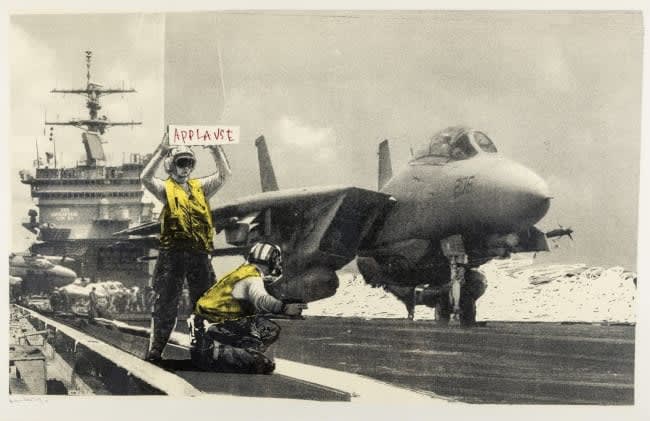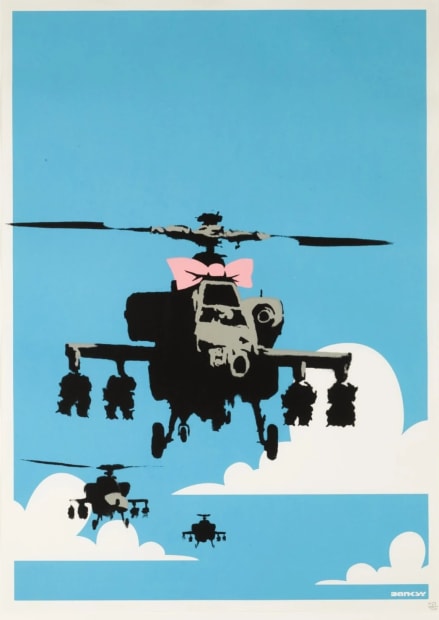
Applause
Banksy’s physically largest print to date, Applause shows a fighter jet on the runway of an aircraft carrier and is based on a well-known image of former US President George W. Bush delivering the mission accomplished speech following the "successful" Iraqi invasion. Flanking the jet are two flight deck traffic controllers clad in bright yellow, high-vis jackets and preparing the fighter jet for take-off. One of the controllers is holding a sign on which is written the word APPLAUSE in capital letters, like those employed in comedy theatres to ask the audience to cheer on cue. Much like in Happy Choppers, we see a weapon of death being subverted and mocked which, whilst not making the machine any more dangerous, helps us as viewers to question and rebel against the military. Buy Applause by Banksy.
Happy Choppers
One of the most popular of all works, Happy Choppers features a squadron of Apache helicopters against a cartoonish sky with pink bows upon them.The machine of death, famously used in the Gulf War, is given the Banksy twist creating a brilliant juxtaposition between violence and laughter. Stylised and cartoonish white clouds reminiscent of crisp candy floss peaks and Super Nintendo era Mario backgrounds dot the skyscape contrasting with the menacing tone of the helicopters. The incoming armed squadron move towards the viewer who is set in their sights and drawn into the piece. Dark colours and realistic stencil lines emphasise the threat of the choppers, armed bombs and weapons at the ready creating a sense of immediate and devastating danger. Learn more about the meaning of Happy Choppers.
Golf Sale
Not many artists are able to successfully ridicule both capitalism and one party state politics yet in Gold Sale Banksy perfectly executes said critique. Virtually identical to the iconic 1989 Tiananmen Square Tank Man photograph (a symbol of rebellion and protest, Banksy recreates the image with his usual stencil style. The protester stands in front of the tank, holding a sign that reads “Golf Sale” which recalls the placard signs commonly seen around high streets in London and many other city centres. In archetypal Banksy style, his biting wit and humour are immediately recognisable. A recurring subject in many of Banksy’s works, the anti-authoritarian message of the piece is perhaps the clearest. A critique on the state and on capitalism, Golf Sale is Banksy at his very best and most punchy - a clear message that protest and rebellion in the face of danger and death are as important now as they were when the famous photograph was taken. Buy Golf Sale by Banksy.
Napalm
Both humorous and repulsive, Napalm is war personified. War, in the literal sense, and both an economic and cultural war led by the USA. If one had to choose a work that captures Banksy then Napalm would be a wise choice - humour, poignancy and cutting, barbed wit. A scintillating attack on commercialism and, specifically, American consumer culture, the work uses the famous and brutal image of Vietnamese girl Phan Thi Kim Phuc (taken by AP photographer Nick Ut) showing her injured and fleeing from a napalm attack. Holding her hand are two powerful symbols of consumerism - Mickey Mouse and Ronald Macdonald. Transforming these two characters, the work takes on a deeply sinister and disturbing tone as childhood and innocence are deeply subverted to create such intense juxtaposition. Buy Napalm by Banksy.
HMV
Weaponry, and its effects, are frequently used in Banksy’s works. Considering an output of around 70 prints, by our reckoning war and violence are themes in roughly 10% of his limited edition prints. In ‘HMV’ we see the artist referencing and repurposing the iconic logo of the famous British music and entertainment company HMV. The logo itself is derivative of a painting by the Liverpudlian artist Francis Barraud that depicts a dog, called Nipper, listening intently to a cylinder phonograph reportedly of his deceased master’s voice. The work shows a seated dog facing a gramophone that has been anthropomorphised by the artist and casually aims at the gramophone. Violence and rebellion occur as the dog, taking arms against its master, to dry comic effect forgoes the usual tropes of being a “good boy”.
As with all of Banksy’s artworks, there is a deeper meaning behind the seemingly simple imagery and HMV is no exception. Could the work be a comment on the old vs the young? An attack on the commercialisation of art in many forms? Provocative and evocative, the work (however it can be read) is one of Banksy’s most well known. Buy HMV by Banksy.
Bomb Hugger
In this artwork, we see a young girl hugging a bomb tightly drawing the munition into her and holding it lovingly to her chest like a beloved toy. Stencilled in black upon a bubblegum pink background, the colours of the work further creates counterpoints between the innocence of the girl, the cold indifferent metal shell of the bomb and the sense that whilst the bomb may come with terrible consequences, the girl innocently does not want to let it go. Much like the rare paintings on canvas entitled, ’Kids On Guns’ Banksy uses weapons and children to bring together two diametrically-opposed subjects creating urgency, dread and intrigue. Indeed, one also wonders if the title “Bomb Love” is a reference to the seminal “Dr. Strangelove or: How I Learned to Stop Worrying and Love the Bomb” which satirizes the Cold War fears of a nuclear conflict between the Soviet Union and the United States. Are we really in danger? Or have we become resigned to our fates and learned to love the bomb. Buy Bomb Hugger by Banksy.
What makes Banksy’s interpretation of such subject matter particularly interesting is how humour and irreverence are used to tackle such hostile topics and thus, almost disarm them.
For more information about any of the prints featured, contact Andipa via sales@andipa.com or call. Discover Banksy original art for sale and Banksy prints for sale and check out our Banksy editions guide.





